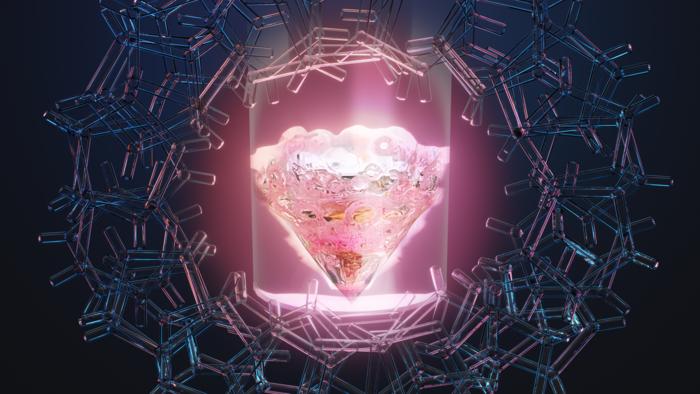Scientists have uncovered the properties of a rare earth element that was first discovered 80 years ago at the very same laboratory, opening a new pathway for the exploration of elements critical in modern technology, from medicine to space travel.

Credit: Jacqueline DeMink, art; Thomas Dyke, photography; ORNL, U.S. Dept. of Energy
Scientists have uncovered the properties of a rare earth element that was first discovered 80 years ago at the very same laboratory, opening a new pathway for the exploration of elements critical in modern technology, from medicine to space travel.
Promethium was discovered in 1945 at Clinton Laboratories, now the Department of Energy’s Oak Ridge National Laboratory, and continues to be produced at ORNL in minute quantities. Some of its properties have remained elusive despite the rare earth element’s use in medical studies and long-lived nuclear batteries. It is named after the mythological Titan who delivered fire to humans and whose name symbolizes human striving.
“The whole idea was to explore this very rare element to gain new knowledge,” said Alex Ivanov, an ORNL scientist who co-led the research. “Once we realized it was discovered at this national lab and the place where we work, we felt an obligation to conduct this research to uphold the ORNL legacy.”
The ORNL-led team of scientists prepared a chemical complex of promethium, which enabled its characterization in solution for the first time. Thus, they exposed the secrets of this extremely rare lanthanide, whose atomic number is 61, in a series of meticulous experiments.
Their landmark study, published in the journal Nature, marks a significant advance in rare earth research and might rewrite chemistry textbooks.
“Because it has no stable isotopes, promethium was the last lanthanide to be discovered and has been the most difficult to study,” said ORNL’s Ilja Popovs, who co-led the research. Most rare earth elements are lanthanides, elements from 57 — lanthanum — to 71 — lutetium — on the periodic table. They have similar chemical properties but differ in size.
The other 14 lanthanides are well understood. They are metals with useful properties that make them indispensable in many modern technologies. They are workhorses of applications such as lasers, permanent magnets in wind turbines and electric vehicles, X-ray screens and even cancer-fighting medicines.
“There are thousands of publications on lanthanides’ chemistry without promethium. That was a glaring gap for all of science,” said ORNL’s Santa Jansone-Popova, who co-led the study. “Scientists have to assume most of its properties. Now we can actually measure some of them.”
The research relied on unique resources and expertise available at DOE national laboratories. Using a research reactor, hot cells and supercomputers, as well as the accumulated knowledge and skills of 18 scientists in different fields, the authors detailed the first observation of a promethium complex in solution.
The ORNL scientists bound, or chelated, radioactive promethium with special organic molecules called diglycolamide ligands. Then, using X-ray spectroscopy, they determined the properties of the complex, including the length of the promethium chemical bond with neighboring atoms — a first for science and a longstanding missing piece to the periodic table of elements.
Promethium is very rare; only about a pound occurs naturally in the Earth’s crust at any given time. Unlike other rare earth elements, only minute quantities of synthetic promethium are available because it has no stable isotopes.
For this study, the ORNL team produced the isotope promethium-147, with a half-life of 2.62 years, in sufficient quantities and at a high enough purity to study its chemical properties. ORNL is the United States’ only producer of promethium-147.
Notably, the team provided the first demonstration of a feature of lanthanide contraction in solution for the whole lanthanide series, including promethium, atomic number 61. Lanthanide contraction is a phenomenon in which elements with atomic numbers between 57 and 71 are smaller than expected. As the atomic numbers of these lanthanides increase, the radii of their ions decrease. This contraction creates distinctive chemical and electronic properties because the same charge is limited to a shrinking space. The ORNL scientists got a clear promethium signal, which enabled them to better define the shape of the trend — across the series.
“It’s really astonishing from a scientific viewpoint. I was struck once we had all the data,” said Ivanov. “The contraction of this chemical bond accelerates along this atomic series, but after promethium, it considerably slows down. This is an important landmark in understanding the chemical bonding properties of these elements and their structural changes along the periodic table.”
Many of these elements, such as those in the lanthanide and actinide series, have applications ranging from cancer diagnostics and treatment to renewable energy technologies and long-lived nuclear batteries for deep space exploration.
The achievement will, among other things, ease the difficult job of separating these valuable elements, according to Jansone-Popova. The team has long worked on separations for the whole series of lanthanides, “but promethium was the last puzzle piece. It was quite challenging,” she said. “You cannot utilize all these lanthanides as a mixture in modern advanced technologies, because first you need to separate them. This is where the contraction becomes very important; it basically allows us to separate them, which is still quite a difficult task.”
The research team used several premier DOE facilities in the project. At ORNL, promethium was synthesized at the High Flux Isotope Reactor, a DOE Office of Science user facility, and purified at the Radiochemical Engineering Development Center, a multipurpose radiochemical processing and research facility. Then, the team performed X-ray absorption spectroscopy at the National Synchrotron Light Source II, a DOE Office of Science user facility at DOE’s Brookhaven National Laboratory, specifically working at the Beamline for Materials Measurement, which is funded and operated by the National Institute of Standards and Technology.
The team also performed quantum chemical calculations and molecular dynamics simulations at the Oak Ridge Leadership Computing Facility, a DOE Office of Science user facility at ORNL, using the lab’s Summit supercomputer, the only computational resource capable of providing the necessary calculations at the time. In addition, the researchers used resources of the Compute and Data Environment for Science at ORNL. They expect future calculations to be performed on ORNL’s Frontier, the world’s most powerful supercomputer and the first exascale system, which is able to perform more than a quintillion calculations each second.
Popovs emphasized that the ORNL-led accomplishments can be attributed to teamwork. Each of the Nature paper’s 18 authors was critical to the project, he said.
The achievement sets the stage for a new era of research, the scientists said. “Anything that we would call a modern marvel of technology would include, in one shape or another, these rare earth elements,” Popovs said. “We are adding the missing link.”
Besides Popovs, Ivanov and Jansone-Popova from ORNL’s Chemical Sciences Division, the paper’s co-authors include Darren Driscoll, Subhamay Pramanik, Jeffrey Einkauf, Santanu Roy and Thomas Dyke, also of ORNL’s Chemical Sciences Division; Frankie White, Richard Mayes, Laetitia Delmau, Samantha Cary, April Miller and Sandra Davern of ORNL’s Radioisotope Science and Technology Division; Matt Silveira and Shelley VanCleve of ORNL’s Isotope Processing and Manufacturing Division; Dmytro Bykov of the National Center for Computational Sciences at ORNL; and Bruce Ravel of the National Institute of Standards and Technology.
This work was primarily co-sponsored by DOE’s Office of Science for ligand synthesis, lanthanide complexation studies, crystallization processes, spectroscopic analyses and simulation efforts. The production, purification and preparation of the promethium sample were supported by the DOE Isotope Program, managed by the Office of Science for Isotope R&D and Production. The single-crystal X-ray diffraction data collection and refinement were supported by the DOE Office of Science.
UT-Battelle manages ORNL for DOE’s Office of Science, the single largest supporter of basic research in the physical sciences in the United States. The Office of Science is working to address some of the most pressing challenges of our time. For more information, please visit energy.gov/science. — Lawrence Bernard and Leo Williams
Journal
Nature
DOI
10.1038/s41586-024-07267-6
Method of Research
Experimental study
Subject of Research
Not applicable
Article Title
Observation of a promethium complex in solution
Article Publication Date
22-May-2024




